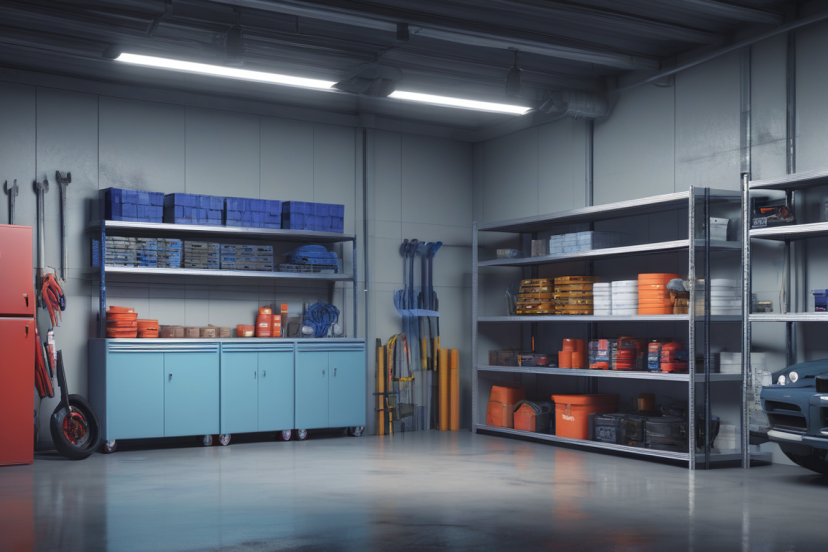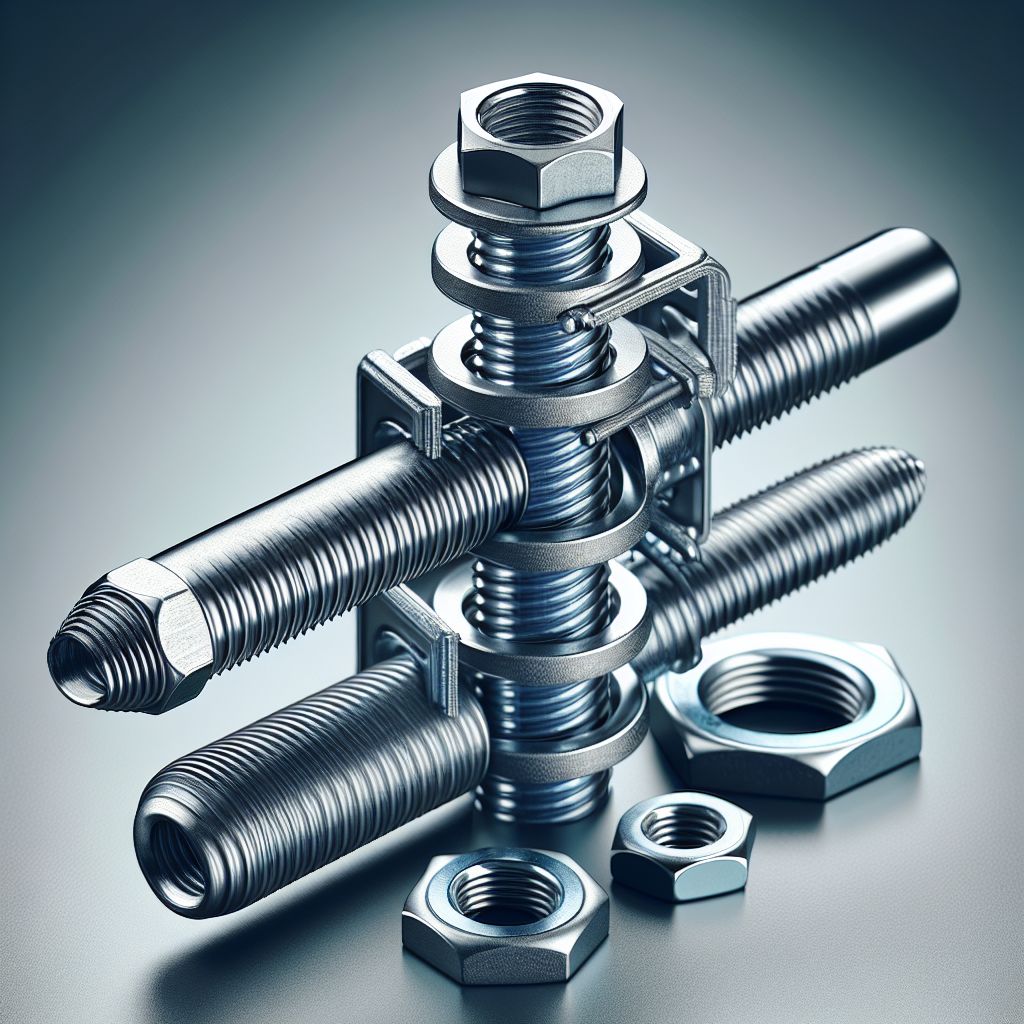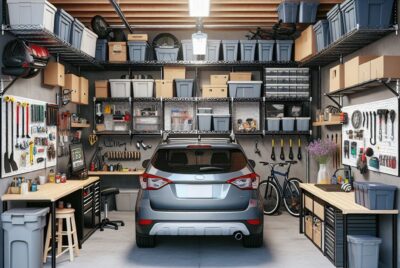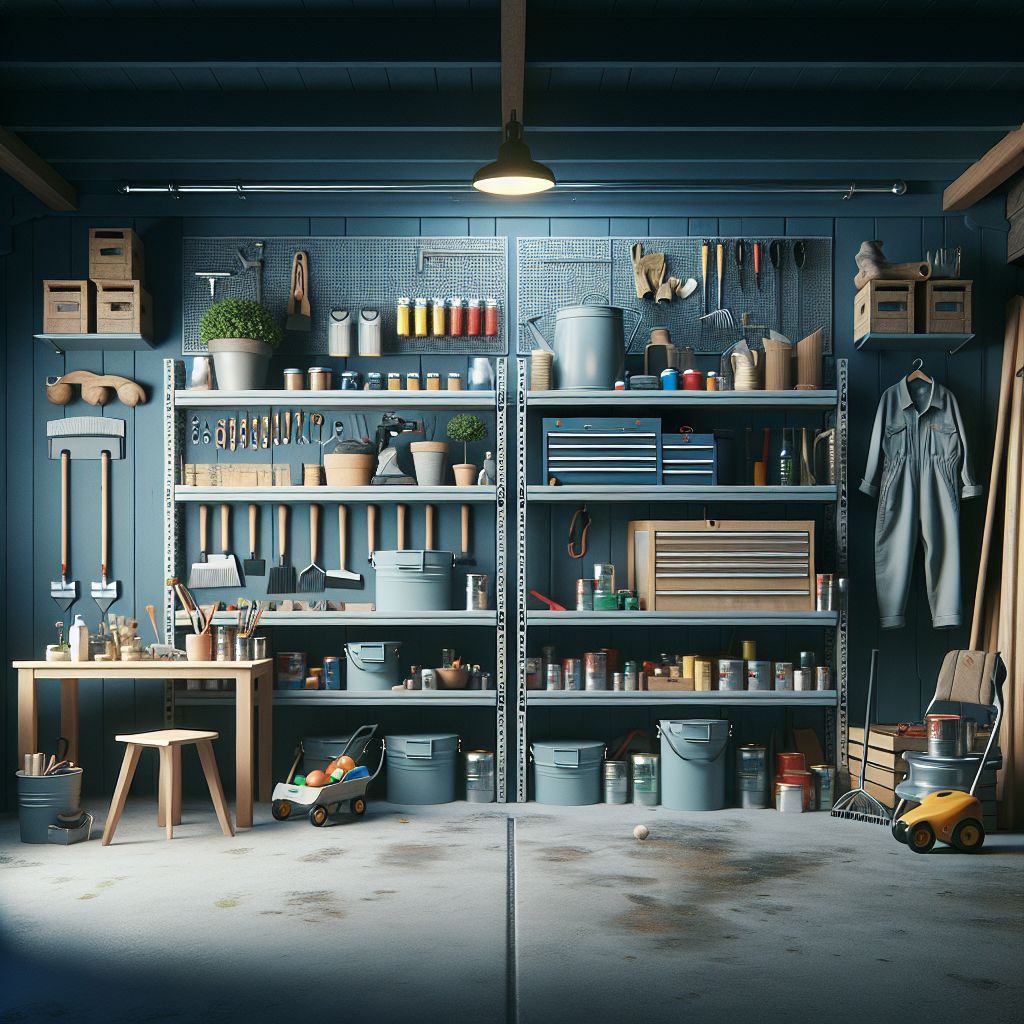Best Space Saving Garage Shelving Ideas & Storage Tips
Key Takeaways
- Wall-mounted shelves maximize vertical space, freeing up the floor for other uses.
- Ceiling-mounted shelves are perfect for storing seasonal items and keeping them out of the way.
- Freestanding shelving units offer flexibility and can be moved around as needed.
- Using hooks and racks efficiently organizes tools and other small items.
- Custom cabinets can be tailored to fit your specific storage needs and aesthetic preferences.
Smart Ways To Maximize Garage Space
Garages often become the catch-all for items that don’t have a designated spot in the house. To truly maximize this space, it’s essential to think vertically and creatively. By using a combination of shelves, hooks, and cabinets, you can transform a cluttered garage into a well-organized storage area.
Let’s explore some effective space-saving garage shelving ideas that will help you reclaim your garage.
Why Garage Organization Matters
An organized garage isn’t just about aesthetics; it has practical benefits too. When your garage is clutter-free, you can find tools and supplies quickly, which saves time and reduces stress. Moreover, an organized garage can also serve as a functional workspace for hobbies and projects.
Quick Overview of Space-Saving Solutions
Before diving into specific shelving ideas, let’s take a quick look at the various options available:
- Wall-Mounted Shelves: Ideal for utilizing vertical space.
- Ceiling-Mounted Shelves: Great for seasonal items and infrequent use.
- Freestanding Shelving Units: Flexible and movable.
- Hooks and Racks: Perfect for tools and small items.
- Custom Cabinets: Tailored storage solutions.
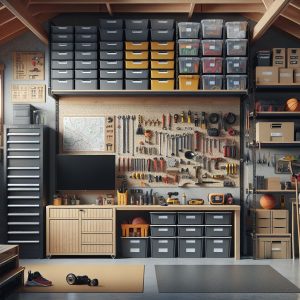
Wall-Mounted Shelves
Wall-mounted shelves are a fantastic way to maximize vertical space in your garage. They free up floor space and keep items easily accessible. There are various types of wall-mounted shelves to consider, each with its own benefits. For more ideas, check out these garage wall ideas.
Types of Wall-Mounted Shelves
Wall-mounted shelves come in different styles and materials, each suited for specific needs. For a comprehensive guide on organizing your garage, check out this garage storage organizing guide.
- Wire Shelves: Lightweight and easy to install, wire shelves are great for storing smaller items.
- Wooden Shelves: Sturdy and durable, wooden shelves can hold heavier items like paint cans and power tools.
- Adjustable Shelves: These shelves can be moved up or down to accommodate items of various heights.
How To Install Wall Mounted Shelves
Installing wall-mounted shelves is a straightforward process. Here’s a step-by-step guide:
- Step 1: Measure the space where you want to install the shelves.
- Step 2: Use a stud finder to locate the studs in the wall.
- Step 3: Mark the positions for the shelf brackets on the wall.
- Step 4: Drill pilot holes and attach the brackets to the wall.
- Step 5: Place the shelves on the brackets and secure them in place.
“Wall-mounted shelves are easy to install and can hold a significant amount of weight if properly anchored to the studs.”
Cost-Effective Options
Wall-mounted shelves can be budget-friendly. Here are some cost-effective options:
- DIY Wooden Shelves: Purchase wooden planks and brackets from a hardware store and assemble them yourself.
- Pre-Made Wire Shelves: These are available at most home improvement stores and are typically affordable.
- Second-Hand Shelves: Check online marketplaces for used shelves that can be repurposed.
Using High Space for Storage
Besides wall-mounted shelves, another excellent way to maximize your garage space is by utilizing the ceiling. Ceiling-mounted shelves are perfect for items that you don’t need to access frequently, like seasonal decorations or camping gear.
Installing Ceiling-Mounted Shelves
Installing ceiling-mounted shelves might seem daunting, but it’s quite manageable with the right tools and instructions. Here’s how you can do it:
- Step 1: Measure the ceiling space and decide the size of the shelves.
- Step 2: Use a stud finder to locate ceiling joists for secure mounting.
- Step 3: Mark the positions for the shelf brackets on the ceiling.
- Step 4: Drill pilot holes and attach the brackets to the ceiling joists.
- Step 5: Place the shelves on the brackets and secure them in place.
Storing Seasonal Items
Ceiling-mounted shelves are ideal for storing seasonal items like holiday decorations, camping gear, or winter sports equipment. These items are only needed once or twice a year, so keeping them out of the way until you need them makes sense. For more ideas, check out these brilliant ways to organize your garage.
“Ceiling-mounted shelves keep seasonal items out of the way, freeing up valuable floor space for everyday use.”
Creating Deep Shelving Units
If you have a lot of items to store, consider installing deep shelving units. These shelves can hold large storage bins, making it easy to keep things organized. Deep shelving units are particularly useful for bulky items like gardening supplies or large tools.
When installing deep shelving units, ensure that they are securely anchored to the wall to prevent tipping. Use heavy-duty brackets and screws to support the weight of the items you’ll be storing.
By utilizing ceiling space and installing deep shelving units, you can significantly increase your garage’s storage capacity without sacrificing floor space.
Advantages of Freestanding Shelves
Freestanding shelving units are incredibly versatile and offer several advantages over other types of shelving. One of the main benefits is that they can be moved around easily. This flexibility allows you to reconfigure your garage layout whenever needed, without the hassle of uninstalling and reinstalling shelves. For more ideas, check out this garage storage organizing guide.
Another advantage is that freestanding shelves can be placed anywhere in the garage, including in the middle of the floor. This makes them ideal for creating separate storage zones for different types of items, such as gardening supplies, sports equipment, and tools.
Moreover, freestanding shelves come in various sizes and styles, making it easy to find a unit that fits your specific needs. Whether you need a tall, narrow shelf for tight spaces or a wide, sturdy unit for heavy items, there’s a freestanding shelf that will work for you.
Materials and Durability
When choosing freestanding shelves, it’s important to consider the materials and durability. The most common materials for these shelves are metal, plastic, and wood, each with its own set of advantages. For more ideas on optimizing your space, check out our garage storage organizing guide.
Metal Shelves: These are typically made of steel or aluminum and are extremely durable. Metal shelves can hold heavy items without bending or breaking, making them ideal for tools and machinery.
Plastic Shelves: While not as strong as metal, plastic shelves are lightweight and resistant to moisture and chemicals. They are a good choice for storing cleaning supplies and other items that might spill.
Wooden Shelves: Wooden shelves offer a classic look and are quite sturdy. However, they can be susceptible to moisture and pests, so it’s important to treat the wood or use it in a dry area of the garage. For more ideas, check out these garage wall ideas.
Incorporating Hooks and Racks
Hooks and racks are essential for organizing smaller items in your garage. They help keep tools, sports equipment, and other items off the floor and within easy reach. By incorporating hooks and racks into your storage system, you can make the most of every inch of space.
Besides that, hooks and racks are relatively inexpensive and easy to install. They can be mounted on walls, doors, and even the sides of shelves, providing versatile storage solutions for various items.
Types of Hooks and Racks for Garage
There are several types of hooks and racks to consider for your garage, each designed for specific uses:
- Utility Hooks: These heavy-duty hooks are perfect for hanging large items like bicycles, ladders, and garden tools.
- Screw-In Hooks: Ideal for smaller tools and equipment, screw-in hooks can be installed directly into wooden surfaces.
- Magnetic Tool Holders: These racks use strong magnets to hold metal tools, making them easy to grab and put away.
- Slatwall Panels: These panels feature horizontal grooves that can hold various hooks and baskets, allowing for a customizable storage solution.
Perfect Items to Hang on Hooks
Hooks and racks are perfect for organizing a variety of items in your garage. Here are some examples:
- Garden Tools: Hang shovels, rakes, and hoes on utility hooks to keep them off the floor and easily accessible.
- Sports Equipment: Use hooks to store bicycles, tennis rackets, and golf bags, freeing up floor space for other uses.
- Power Tools: Magnetic tool holders are great for keeping drills, saws, and other power tools within reach.
- Extension Cords: Prevent tangling by hanging extension cords on screw-in hooks or specialized cord organizers.
“Using hooks and racks to organize your garage not only saves space but also makes it easier to find and access your tools and equipment.”
Using Custom Cabinets
Custom cabinets offer a tailored storage solution that can be designed to fit your specific needs and preferences. Whether you need a cabinet for tools, sports equipment, or household supplies, custom cabinets can provide the perfect storage solution for your garage.
Besides providing ample storage space, custom cabinets can also enhance the overall look of your garage. With a variety of materials, finishes, and hardware options to choose from, you can create a cohesive and stylish storage system that complements the rest of your home.
Custom vs. Prefab Cabinets
When it comes to garage cabinets, you have two main options: custom cabinets and prefabricated (prefab) cabinets. Each has its own set of advantages and disadvantages.
Custom Cabinets: These are built to your specifications, allowing you to choose the size, materials, and design. Custom cabinets offer the best fit and finish, but they can be more expensive and take longer to install.
Prefab Cabinets: Prefab cabinets are mass-produced and available in standard sizes and designs. They are typically less expensive and quicker to install, but they may not fit your space or needs as perfectly as custom cabinets.
Cabinet Design Ideas that Save Space
When designing custom cabinets for your garage, consider incorporating space-saving features like garage wall ideas:
- Sliding Doors: Sliding doors take up less space than traditional hinged doors, making them ideal for tight spaces.
- Adjustable Shelves: Shelves that can be moved up or down allow you to store items of various heights more efficiently.
- Built-In Workbench: Incorporate a workbench into your cabinet design to create a functional workspace without taking up additional floor space.
- Overhead Storage: Use the upper sections of your cabinets for storing infrequently used items, keeping them out of the way but still accessible.
Tips for Organizing Cabinets
Once your cabinets are installed, it’s important to organize them effectively. Here are some tips to help you get started:
- Group Similar Items Together: Store similar items, such as gardening tools or cleaning supplies, in the same cabinet to make them easier to find.
- Use Clear Containers: Clear plastic bins allow you to see what’s inside without having to open them, making it easier to locate items.
- Label Everything: Use labels to identify the contents of each shelf or bin, so you can quickly find what you need.
- Keep Frequently Used Items Accessible: Store items you use often on lower shelves or at eye level for easy access.
Bins and Baskets
Bins and baskets are essential for keeping small items organized and easy to find. They can be used on shelves, in cabinets, or even mounted on walls to maximize storage space. By using bins and baskets, you can keep your garage tidy and ensure that everything has a designated place.
Best Types of Storage Bins
When choosing storage bins for your garage, consider the following options: container garage solutions.
- Plastic Bins: Durable and moisture-resistant, plastic bins are ideal for storing items that need protection from the elements.
- Stackable Bins: These bins can be stacked on top of each other, saving space and keeping items organized.
- Clear Bins: Clear bins allow you to see the contents without opening them, making it easier to find what you need.
- Label-Friendly Bins: Bins with built-in label holders make it easy to identify the contents and keep everything organized.
Labeling for Easy Identification
Labeling your bins and baskets is crucial for maintaining an organized garage. Here are some tips for effective labeling: For more comprehensive advice on organizing your garage, check out this garage storage organizing guide.
- Use a Label Maker: A label maker produces clear, professional-looking labels that are easy to read.
- Color-Code Labels: Use different colors for different categories of items, such as red for tools and blue for sports equipment.
- Include Detailed Descriptions: Be specific about the contents of each bin, such as “Garden Tools” or “Holiday Decorations.”
- Update Labels Regularly: As you add or remove items, update the labels to reflect the current contents of each bin.
Stacking Baskets for Max Efficiency
Stacking baskets are a great way to maximize storage space in your garage. They can be used to store a variety of items, from small tools to sports equipment. Here are some tips for using stacking baskets effectively:
For more ideas on how to organize your garage, check out these brilliant ways to organize your garage.
- Choose Sturdy Baskets: Make sure the baskets are strong enough to hold the items you plan to store.
- Use Uniform Sizes: Baskets of the same size stack more neatly and save space.
- Label Each Basket: Label each basket with its contents to make it easy to find what you need.
- Store Heavier Items on the Bottom: Place heavier items in the lower baskets to prevent tipping and make the stack more stable.
“Stacking baskets are a versatile and efficient way to organize your garage, keeping small items contained and easy to access.”
Regular Cleaning Schedule
Maintaining an organized garage isn’t a one-time task; it requires regular upkeep. Establishing a regular cleaning schedule can help you keep the clutter at bay. Aim to clean your garage at least once a month. During these sessions, sweep the floor, dust the shelves, and wipe down surfaces. Regular cleaning prevents dust and dirt from accumulating and keeps your storage systems in top shape.
Periodic Review and Decluttering
Besides regular cleaning, it’s essential to periodically review and declutter your garage. Set aside time every few months to go through your belongings and get rid of items you no longer need. This might include old tools, broken equipment, or items you haven’t used in years. Donate, recycle, or dispose of these items responsibly.
“Decluttering your garage regularly helps you maintain an organized space and makes it easier to find the items you truly need.”
During your decluttering sessions, take note of any items that could benefit from a different storage solution. For example, if you notice that your sports equipment is always scattered, consider adding more hooks or a dedicated rack.
Efficient Space Utilization Practices
Efficient space utilization is key to maintaining an organized garage. Here are some practices to help you make the most of your space: consider installing space-saving solutions to maximize your storage capacity.
- Use Vertical Space: Install wall-mounted shelves and hooks to keep items off the floor.
- Maximize Ceiling Space: Use ceiling-mounted shelves for seasonal items and infrequently used belongings.
- Create Zones: Designate specific areas for different types of items, such as tools, sports equipment, and gardening supplies.
- Label Everything: Clearly label shelves, bins, and cabinets to make it easy to find and return items to their proper place.
- Adjust as Needed: Be flexible and willing to adjust your storage solutions as your needs change.
Final Thoughts
Organizing your garage might seem like a daunting task, but with the right strategies and tools, it can become a manageable and even enjoyable project. By implementing space-saving shelving ideas and maintaining a regular cleaning and decluttering schedule, you can transform your garage into a functional and organized space.
Remember, the key to a well-organized garage is to make the most of every inch of space. Use a combination of wall-mounted shelves, ceiling-mounted shelves, freestanding units, hooks, racks, and custom cabinets to create a storage system that works for you. For more ideas, check out this garage storage organizing guide.
Recap of Key Points
Let’s recap the key points for creating an organized garage: for a comprehensive guide on decluttering and space-saving solutions, check out our garage storage organizing guide.
- Wall-mounted shelves maximize vertical space and keep items easily accessible.
- Ceiling-mounted shelves are perfect for storing seasonal items and keeping them out of the way.
- Freestanding shelving units offer flexibility and can be moved around as needed.
- Hooks and racks efficiently organize tools and other small items.
- Custom cabinets can be tailored to fit your specific storage needs and aesthetic preferences.
Encouragement for DIY Implementation
Don’t be intimidated by the prospect of organizing your garage. Start small, and tackle one section at a time. Whether you’re installing wall-mounted shelves or setting up hooks and racks, each step you take brings you closer to a clutter-free garage. Remember, the effort you put in now will pay off in the long run with a more functional and enjoyable space. For more tips, check out this garage storage organizing guide.
Keep Adapting Your Space
As your needs and interests change, so should your garage. Be open to adjusting your storage solutions and trying new ideas. Keep an eye out for new tools and systems that can help you stay organized. By continually adapting your space, you’ll ensure that your garage remains a useful and pleasant part of your home.
Frequently Asked Questions (FAQ)
- What materials are best for garage shelving?
- How much weight can wall-mounted shelves hold?
- How do I choose the right storage bins?
Choosing the right materials for your garage shelving is crucial for durability and functionality. Metal shelves are strong and can hold heavy items, while plastic shelves are lightweight and resistant to moisture. Wooden shelves offer a classic look but need to be treated to prevent damage from moisture and pests. For more tips, check out our garage storage organizing guide.
What materials are best for garage shelving?
Metal shelves are the best option for heavy items due to their strength and durability. Plastic shelves are suitable for lighter items and are resistant to moisture and chemicals. Wooden shelves provide a sturdy and attractive option but require treatment to protect against moisture and pests.
How much weight can wall-mounted shelves hold?
The weight capacity of wall-mounted shelves depends on the materials and installation. Metal shelves mounted on studs can hold up to 200 pounds or more. Wooden shelves with sturdy brackets can support around 100-150 pounds. Always check the manufacturer’s specifications and ensure proper installation to maximize weight capacity. For more ideas on organizing your garage, check out these brilliant ways to organize your garage.
How do I choose the right storage bins?
- Consider the material: Plastic bins are durable and moisture-resistant, while fabric bins are lightweight and flexible.
- Look for stackable options to save space.
- Choose clear bins for easy identification of contents.
- Ensure the bins have labels or label holders for easy organization.
By selecting the right storage bins, you can keep your garage organized and make it easy to find what you need when you need it.
With these tips and strategies, you’re well on your way to creating an organized and functional garage. For more ideas, check out this garage storage organizing guide. Happy organizing!
*We may earn a commission for purchases made using our links. Please see our Disclosure to learn more.

